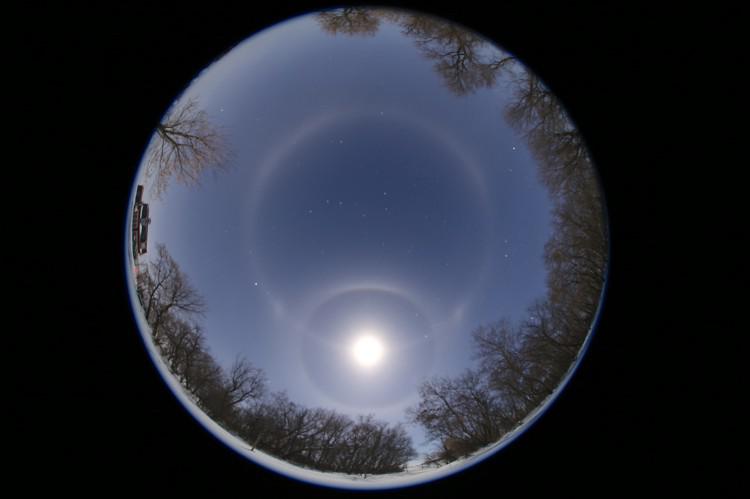This page describes an image Selene meets the Moon, by Sheila Wiwchar, Canada
Caption:
First place in the 2021 IAU OAE Astrophotography Contest, category Sun/Moon haloes.
Photographed at Kaleida, Manitoba in Canada, this fisheye image beautifully captures the rare optical phenomena encircling the moon known as the “22° halo” and the horizontal white circle passing through the moon called the “paraselenic circle”. The white band circling the whole sky at the same altitude as the moon is named after Selene, the ancient Greek Titan, famously called the goddess of the moon. The more commonly observed counterpart produced by the sun is known as the parhelic circle, named after the Greek god of the sun, Helios. Both the 22° halo and the paraselenic circle are produced due to reflection of the moonlight from near vertical surfaces of ice crystals. Parts closer to the moon are caused due to external reflections, whereas those further away are created due to internal reflections. The constellation of the big dipper at the center makes this image even more spectacular. Can you spot it?
Credit:
Sheila Wiwchar/IAU OAE
DOI: 10.5281/zenodo.5418731
Related glossary terms:
Halo
, Moon
Categories:
Naked Eye Astronomy
License: Creative Commons Attribution 4.0 International (CC BY 4.0) Creative Commons Attribution 4.0 International (CC BY 4.0) icons
The media file captions presented on the OAE website were written, translated and reviewed by a collective effort from the OAE, the OAE Centers and Nodes, the OAE National Astronomy Education Coordinators (NAECs) and other volunteers. You can find a full list of credits for our translation project here. All media file captions are released under a Creative Commons CC BY-4.0 license and should be credited to "IAU OAE". The media files themselves may have different licenses (see above) and should be credited as listed above under "credit".
Captions in Different Languages:
Caption: Primo posto al concorso di astrofotografia IAU OAE 2021, categoria Aloni di Sole/Luna.
Fotografata a Kaleida, Manitoba in Canada, questa immagine fisheye cattura magnificamente il raro fenomeno ottico che circonda la luna noto come "alone a 22°" e il cerchio bianco orizzontale che attraversa la luna chiamato "cerchio paraselenico". La fascia bianca che circonda l'intero cielo alla stessa altitudine della luna prende il nome da Selene, l'antico Titano greco, notoriamente chiamato la dea della luna. La controparte più comunemente osservata prodotta dal sole è nota come cerchio paraselenico, dal nome del dio greco del sole, Helios. Sia l'alone di 22° che il cerchio paraselenico sono prodotti dalla riflessione della luce lunare da superfici quasi verticali di cristalli di ghiaccio. Le parti più vicine alla luna sono causate da riflessioni esterne, mentre quelle più lontane sono create da riflessioni interne. La costellazione dell'Orsa Maggiore al centro rende questa immagine ancora più spettacolare. Riuscite a individuarla?
Credit: Sheila Wiwchar/IAU OAE
Related glossary terms: L'alone , Luna Caption translation status: Approved by a reviewer
Caption translators: Giuliana Giobbi, Francesco Salvestrini
Caption reviewers: Rosa Valiante, Rodolfo Canestrari









